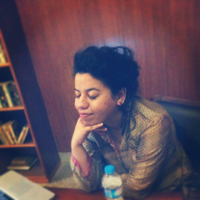More about Look Mickey

Contributor
Before Roy Lichtenstein was the Roy Lichtenstein that we all know and possibly even love, he was actually grasping at straws to make it in the art world.
So much so, that he ended up bastardizing an image from the pages of one of those Little Golden Books - a staple in most of our childhood bookshelves. Look, Mickey was Lichtenstein’s breakthrough work. Before this he had been struggling with not-so-hot Abstract Expressionist pieces, which no one gave a damn about. But one of his first stabs at making Mickey wasn’t in this painting. It was actually 4 years earlier when he tried stenciling a projected drawing of the famed rodent on his son’s bedroom wall. This got him thinking about cartoons during his drought of pictures to draw. So after a few somewhat botched attempts at drawing cartoons on canvas, he finally ended up making this piece…which really didn’t stray too far from the original source. Except for a few modifications of course: Roy used bold, saturated primary colors in place of the original color palette which looks like this, and of course, he added a speech bubble.
The speech bubble and Donald are actually in some ways symbolizing Roy and his new discovery in Western art, which was this newfangled type of image that soon became classified as Pop Art. But Roy was worried that this kind of painting didn’t really qualify as art and was a bit hesitant to push it further. Though once he did, with the addition of his signature Ben-Day dots and black outlines, we all know that those floodgates never closed! Critics all around didn’t also immediately love it. In a 1964 issue of Life Magazine, this painting was printed alongside with the question: “Is he the worst artist in the U.S.?” Harsh!! But we all know America was weaning itself from the tired teat of Abstract Expressionism and the art world was suspicious of newcomers with their new wave of imagery. Critics be damned though, the masses were into it. It also helps when one of the city’s coolest gallerists (Leo Castelli, in this case) thinks your work is groovy.
So the last laugh may look like it’s on Mickey, but little does he know that he’s representing that worn-out old technique: Abstract Expressionism. While Roy/Donald is moving into the future and yelling, “Look Mickey, I’ve hooked a big one!” You certainly have, Roynald.
Featured Content
Here is what Wikipedia says about Look Mickey
Look Mickey (also known as Look Mickey!) is a 1961 oil on canvas painting by Roy Lichtenstein. Widely regarded as the bridge between his abstract expressionism and pop art works, it is notable for its ironic humor and aesthetic value as well as being the first example of the artist's employment of Ben-Day dots, speech balloons and comic imagery as a source for a painting. The painting was bequeathed to the Washington, D.C., National Gallery of Art upon Lichtenstein's death.
Building on his late 1950s drawings of comic strip characters, Look Mickey marks Lichtenstein's first full employment of painterly techniques to reproduce almost faithful representations of pop culture and so satirize and comment upon the then developing process of mass production of visual imagery. In this, Lichtenstein pioneered a motif that became influential not only in 1960s pop art but continuing to the work of artists today. Lichtenstein borrows from a Donald Duck illustrated story book, showing Mickey Mouse and Donald Duck during a fishing mishap. However, he makes significant alterations to the original source, including modifying the color scheme and perspective and adding a speech balloon, changing the original joke.
The work dates from Lichtenstein's first solo exhibition, and is regarded by art critics as revolutionary both as a progression of pop art and as a work of modern art in general. It was later reproduced in his 1973 painting Artist's Studio—Look Mickey, which shows the painting hanging prominently on a facing wall of Lichtenstein's studio.
Check out the full Wikipedia article about Look Mickey













